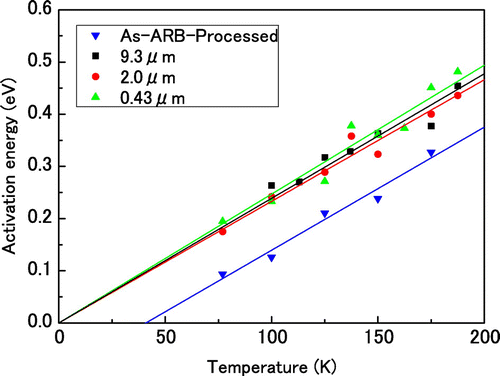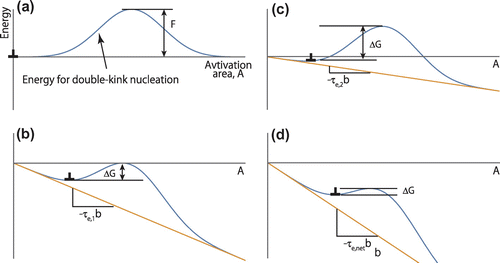Abstract
The effects of severe plastic deformation on the thermal activation of dislocation gliding in ultralow-carbon steel at low temperatures were investigated. This was done by measuring the temperature dependences of the effective stress, activation volume and activation energy. It was found that the values of all these parameters were lower than those for coarse-grained specimens at low temperatures. In coarse-grained materials, the activation energy should increase with a decrease in the effective stress. This phenomenon, which seemed counterintuitive initially, could be physically interpreted on the basis of the fluctuation in the athermal stress.
1. Introduction
Materials subjected to severe plastic deformation (SPD) show outstanding mechanical properties such as high strength and toughness [Citation1–7], in contrast to coarse-grained materials. In addition, it has been reported that, in severally deformed Cu, the activation volume exhibits an inverse dependence on temperature. The activation volume in Cu subjected to SPD decreases with temperature, while in coarse-grained Cu, it increases [Citation6,8]. This peculiar behaviour of the activation volume in severely deformed Cu can be explained by a model according to which the activation process of dislocations in severely deformed Cu is different from that in coarse-grained Cu. In order to explain the inverse temperature dependence of the activation volume in severely deformed Cu, Kato et al. assumed that the thermally activated process, in SPDed, Cu is the depinning of the dislocations from the grain boundaries introduced in large numbers by the grain refinement caused by the SPD. Using this model, they showed that lower the bow-out radius of the dislocations during the depinning event, the lower the effective stress at higher temperatures. They calculated the temperature dependence of the activation volume based on their model and demonstrated that the activation volume decreases with the temperature by assuming that one side of the pinned dislocations at the grain boundaries is depinned during the thermally activated process. They showed that grain boundaries play an important role in the thermally activated process in SPD materials. They also suggest that the thermally activated process of dislocation gliding in severely deformed Cu is different from that in coarse-grained Cu.
In pure body-centred cubic (bcc) metals, the dominant activation process of dislocation gliding varies with the test temperature. At low temperatures, including those much lower than room temperatures, the main obstacles for dislocation gliding are the short-range barriers such as the Peierls potential. On the other hand, at middle temperatures, such as those between room temperature and approximately Tm/2 for irons, where Tm is the melting point in Kelvin, the main hindrances are the long-range barriers such as dislocation–dislocation interactions. In pure face-centred cubic (fcc) crystals, the Peierls potential is negligibly small. Thus, the thermal component of the flow stress is limited to processes such as the cutting of the forest dislocation cores. Instead, the athermal component attributable to long-range dislocation–dislocation interactions becomes dominant.
The effects of SPD on the activation process in bcc metals at low temperatures are expected to be different from those in coarse-grained bcc metals or fcc metals, because the dominant stress component for dislocation gliding is not only the Peierls (or double-kink nucleation) stress, but also the athermal stress necessary for overcoming the long-range stress caused by the high-density dislocations introduced by the SPD process. In these materials, dislocation gliding is the motion in the coexistence of high short-range and long-range barriers. Therefore, in the present study, we investigated the effects of SPD on the activation process in Ti-added ultralow-carbon steels at low temperatures by analysing the temperature dependences of the yield stress and the activation volume. In addition, the effects on the thermal activation of the dislocations introduced by the SPD process are discussed.
2. Experimental procedure
A Ti-added ultralow-carbon steel with 0.009 mass% P was used in this study; its chemical composition is shown in Table . Accumulative roll bonding (ARB) [Citation9] was performed, in order to introduce SPD. The specimen was hot-forged at temperatures between 1173 and 1473 K and then cold-rolled with a reduction of 80% in the thickness. The grain size was not measured before and after the cold-rolling process. After the surface of every sheet had been degreased and wire-brushed, two of the 1-mm-thick sheets were stacked on top of each other, and their fronts and backs were spot welded. This stacked set of sheets was then held at 773 K for 600 s in a furnace and then roll-bonded to an approximately 50% reduction in thickness. The ARB process was repeated five times. The total equivalent strain introduced was 5.6, including the reduction due to the cold rolling of the starting materials. The strain was calculated basing on the von Mises equivalent strain equation. After the completion of the ARB process, the sheets were annealed to obtain specimens with different grain sizes. Figure shows back-scattered electron images taken along the transverse directions. Figure (a) shows the as-ARB-processed specimen. It can be seen that its grains were elongated in the rolling (horizontal) direction. The grain size was found to be 0.11 μm; this was defined as a shorter diameter of the grains. Figure (b)–(d) shows the specimens after they had been annealed at 923 K for 1.8 ks and then cooled in air, annealed at 973 K for 3.6 ks and then cooled in air cooling, and annealed at 1048 K for 0.9 ks and then cooled in a furnace, respectively. The grains in (b), (c) and (d) are more equiaxed; this indicates that recrystallisation had started. The mean grain sizes in (b), (c) and (d) were found to be, 0.43, 2.0 and 9.3 μm, respectively. Specimens for the tensile test were prepared such that they had a parallel section with a length of 5 mm and width of 1.2 mm. The tensile tests were performed at temperatures between 77 and 350 K at an initial strain rate of 4.3 × 10−4 s−1. Strain-rate jump tests were also performed after the specimens had yielded; the jumped strain rate was 4.3 × 10−3 s−1. The strain was measured with a strain gauge and was approximately 0.02.
Table 1. Chemical composition of the alloy used in this study.
3. Results
Figure (a)–(d) shows nominal stress–strain (s–s) curves obtained for the as-ARB-processed specimen and the annealed specimens with the grain sizes of 0.43, 2.0 and 9.3 μm, respectively, as tested at various temperatures. The s–s curves were measured using strain gages with the measurable maximum strain of 0.02. The s–s curves were terminated in the figure at the point when the strain gages were detached during the experiments. Strain-rate jump tests were also performed at the strain indicated by the arrows in the figure; these will be explained later. The 0.002 proof stress was employed as a yield stress in (a)–(c), in which continuous yielding occurs. On the other hand, a lower yield stress was used in (d), in which discontinuous yielding was observed. In all the specimens with different grain sizes, the yield stress decreased with temperature as expected. Note, only the specimen with the increase in the grain size of 9.3 μm was fractured in a brittle manner at 77 K within the strain of 0.02. Since the temperature dependence of the yield stress depends on the grain size, the yield stress was measured at a series of temperature for all the specimens.
Figure 1. Back-scattered images of the specimens with grain sizes of (a) 0.11 μm, (b) 0.43 μm, (c) 2.0 μm and (d) 9.3 μm. The specimen in (a) is the as-ARB-processed one, while those in (b)–(d) are the annealed ones.
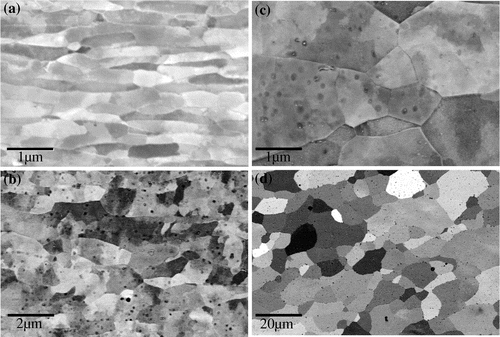
Figure 2. (colour online) Stress–strain curves for the various specimens at different temperatures, obtained using strain gages. The s–s curves are limited to the point where the strain gages became detached. The arrows indicate the points at which strain-rate jump tests were performed. (a) as-ARB-processed specimen and specimens with a grain size of (b) 0.43 μm; (c) 2.0 μm; and (d) 9.3 μm.
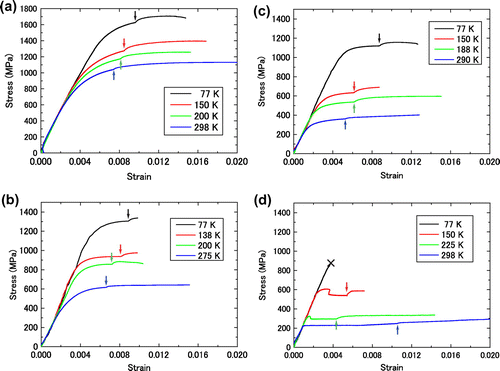
Figure shows the temperature dependence of the yield stress for the annealed specimens with grain sizes of 9.3, 2.0 and 0.43 μm, as well as an as-ARB-processed specimen. The specimens with the smaller grain sizes exhibited higher yield stresses at all temperatures. The as-ARB-processed specimen exhibited the highest yield stress at all temperatures; this was owing to the effects of both grain refining and work hardening.
Figure 3. (colour online) Temperature dependence of the yield stress for the specimens with different grain sizes. The regression curves are overlaid.
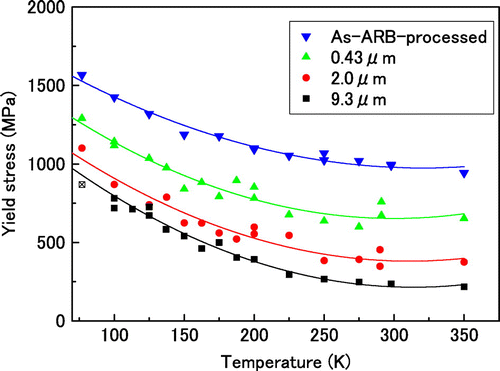
Figure shows SEM images of the specimens after rupture during the tensile deformation at room temperature or 100 K; these samples were not subjected to the strain-rate jump tests. Tensile tests were continued for these specimens till they ruptured after local necking. At room temperature, the degree of necking becomes more significant as the grain size increases. This is due to the fact that ultrafine-grained materials tend to have less ability of work hardening. The tendency is observed even at 100 K, even though the extent of necking is lower. The as-ARB-processed specimen as well as the specimens with the grain sizes of 0.43 and 2.0 μm ruptured along layer boundaries, which were formed in the specimen during the ARB process. Although the local necking property also depends on the grain size, we did not go further till that point. The yield behaviour, which is directly influenced by dislocation gliding, will be discussed next.
Figure 4. SEM images of the specimen surfaces observed from the normal direction after tensile tests at room temperature ((a)–(d)) and 100 K ((e)–(h)). The tensile tests were continued until the specimens ruptured after local deformation. (a), (e) as-ARB-processed specimen and specimens with a grain size of (b), (f) 0.43 μm; (c), (g) 2.0 μm; and (d), (h) 9.3 μm.

The yield stress, σy, at any given temperature consists of two components: the effective stress, σe and the athermal stress, σath.(1)
Here, σe is temperature dependent, while σath is not. The values of σath were determined from Figure as follows. First, the yield stress values were fitted using a parabolic curve, and the temperature dependence of the yield stress was analysed. Till the curve did not exhibit a minimum point for temperatures tested, the tensile test was performed at increasingly higher temperatures. That is to say, the test was repeated until the parabolic curve exhibited a distinct lowest point. The stress at this point was considered to be the σath value in this study. In fact, the yield stress was nearly similar to the σath for temperatures higher than that corresponding to the lowest point in the regression curve. Athermal stress is considered to be attributable to long-range barriers such as grain boundaries, large precipitates and dislocation–dislocation interactions. The increase in the athermal stress because of the change in the grain size from 9.3 to 0.23 μm was probably owing to the effect of the Hall–Petch relationship [Citation10,11]. The role of the grain boundaries as long-range barriers is that they act as obstacles to dislocation motion. In case of the as-ARB-processed specimen, a large number of dislocations were present, so that the effect of the dislocation–dislocation interactions overlapped with that of the grain boundaries, resulting in the athermal stress.
Figure shows the temperature dependence of σe, as determined from Figure and Equation (1). The regression curves for the various specimens were obtained as follows:(2)
(3)
(4)
(5)
Figure 5. (colour online) Temperature dependence of the effective stress for the specimens with different grain sizes. The regression curves are overlaid.
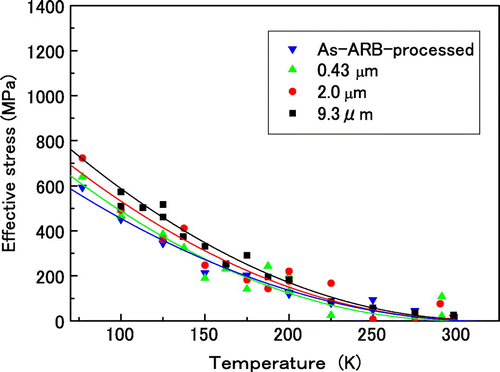
Equations (2)–(5) suggest that the slope of the regression curve in Figure for the as-ARB-processed specimen is lower than those of the curves of the other specimens and that the slopes of the curves of the other specimens are almost similar. The term with T in Equations (2)–(5) is primarily responsible for the observed differences in the effective stress. This suggests that the change in the effective stress is larger at lower temperatures than that at room temperature. Figure also indicates that the thermally activated process in the case of the as-ARB-processed specimen is not exactly the same as those for the other specimens. Therefore, the activation energy for dislocation glide was measured next.
The shear strain rate in the double-kink nucleation model in the case of the Peierls mechanism is given by the following equation [Citation12]:(6)
where ΔG is the activation energy for dislocation gliding, is the pre-exponential factor, k is the Boltzmann constant and T is the absolute temperature. Further, τe is the effective stress given by
, where M is the Taylor factor. Equation (6) can now be written as follows:
(7)
where V* is the activation volume. The value of V* is defined as follows with the strain rate in tensile tests [Citation13]:
(8)
∂σe was obtained from the results of the strain-rate jump tests. For example, the strains indicated by arrows in Figure increases the strain rate by one-order magnitude. The value of the activation volume is determined by multiplying the activation area and the Burgers vector, A*b, where A* is the activation area. Dislocations swipe the area A* during the thermally activated process, when they move under the effective stress, τe. Figure shows that ∂σe increased with a decrease in temperature for all the specimens for this temperature step. In order to determine the change in the activation volume from Equation (8), the strain-rate jump tests were performed for a greater number of temperatures between those shown in Figure . Figure shows the temperature dependence of the activation volume as determined from Equation (8). Although a number of values have been suggested for the Taylor factor [Citation14–17], M was taken as 2 in this study under the assumption that there should be a slip system with a Schmid factor of nearly 0.5, because of the large number of slip systems in bcc structures [Citation15]. Although there is a small degree of scattering in the obtained activation volume over the range of temperatures investigated, the value for the as-ARB-processed specimen was lower than those of the others at temperatures lower than 150 K. This indicated that the thermally activated process of dislocation gliding in the as-ARB-processed specimen was different from those in the annealed specimens.
Figure 6. (colour online) Temperature dependence of the activation volume for the specimens with different grain sizes.
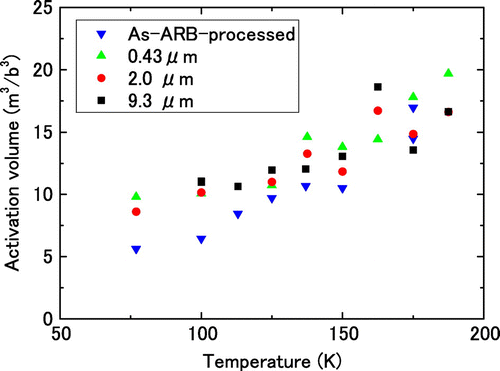
The temperature dependence of the activation energy was also determined using Equations (7) and (8), using the experimental data obtained in this study. Figure shows the temperature dependence of the activation energy for dislocation gliding. It is to be noted that the value of the activation energy is in good agreement with that for single-crystalline low-carbon steel [Citation18], which indicates that the value of the Taylor factor taken in this study is a reasonable one. It can be seen that the activation energies for the specimens with grain sizes of 9.3, 2.0 and 0.43 μm were almost similar, while that of the as-ARB-processed specimen was lower at all temperatures less than 200 K. This indicated that, in the case of the as-ARB-processed specimen, the dislocation velocity with respect to thermally activated processes was higher than that for the other specimens. The reason why the activation energy for dislocation gliding was the lowered in the case of the as-ARB-processed specimen is discussed next.
4. Discussion
4.1. Decreases in activation energy and activation volume
Generally, in coarse-grained materials, the activation energy increases with a decrease in the effective stress. Here, the changes in the activation energy and effective stress in the as-ARB-processed specimen were compared with those for the specimen with the grain size of 9.3 μm. The effective stress in the as-ARB-processed specimen is lower than that of the specimen with the grain size of 9.3 μm at lower temperatures. This suggests that the activation energy in the as-ARB-processed specimen is lower than that of the specimen with a grain size of 9.3 μm for the same temperature, as shown in Figures and . This phenomenon seemed to be contradictory initially. Thus, we attempted to elucidate this phenomenon by physically interpreting it.
The activation energy for dislocation gliding, which is controlled by double-kink nucleation, is given by the following equation:(9)
where F is the Helmholtz free energy for double-kink nucleation. Therefore, one can assume the following:(10)
In this study, the activation energy for the as-ARB-processed specimen was lower than those of the other specimens for all temperatures lower than 200 K. The regression lines shown in Figure were used to obtain the values of ΔG at 77 K for the specimen with a grain size of 9.3 μm and the as-ARB-processed specimen. The difference in the activation energies of the two specimens, dΔG, was approximately –0.08 eV. The negative value of dΔG was owing to the changes in τeV*. It should be noted that d(τeV*) must be positive in order for the experimentally determined value of dΔG to be negative. Figures and show that the dτe and dV* values for the 9.3-μm-grain and as-ARB-processed specimens were both negative; this suggested that the sign of the right side of Equation (10) should be positive.
Figure shows a schematic representation of Equation (9); here, the x-axis represents the activation area, and the y-axis represents the energy level of the dislocations. The energy barrier is for the double-kink nucleation caused by a high Peierls potential. Only a short-range barrier is shown for simplicity. It is assumed that there is a screw dislocation lying at the bottom of the Peierls potential well, as shown in Figure (a), where the height of the potential corresponds to F in Equation (9). When an effective stress, τe,1, is applied to a dislocation of unit length, the potential of the dislocation is decreased to τe,1bA, where A is the activation area. Therefore, ΔG can be obtained by subtracting τe,1bA from F, as shown in Equation (9). The value of ΔG is the barrier that the dislocation needs to overcome to move to the next equilibrium position under the effective stress of τe,1 as shown in Figure (b). If the effective stress is changed from τe,1 to τe,2 (|τe,2| < |τe,1|), then ΔG should increase, as shown in Figure (c); this change in ΔG with dτe is as expected for normal dislocation gliding. In addition, the activation volume should increase with the decrease in the absolute value of the effective stress. Figures (c) and (d) also show that, when the sign of dV* is negative, the sign of dτe must be positive. These behaviours are to be expected in the case of normal materials. It was observed that the absolute values of ΔG, τe and V* decreased simultaneously in the case of the as-ARB-processed specimen, in contrast to the cases for coarse-grained specimens. In order to account for this contradiction seen in the as-ARB-processed specimen, the fluctuation in the athermal stress was taken into account, as explained next.
4.2. Effects of fluctuations in athermal stress on thermally activated process of dislocation gliding and effective stress in bcc metals
In normal-grained bcc metals at low temperatures, the effective stress for overcoming the Peierls barrier is much higher than the athermal stress owing to the internal stress of dislocations. On the other hand, in specimens such as those subjected to ARB processing, the athermal stress is markedly higher, because of the large number of dislocations introduced by the SPD process. Therefore, even at low temperatures, the ratio of the athermal stress to the effective stress should be higher. Further, in ARB-processed materials, there should be large fluctuations in the athermal stress field, owing to the presence of a large number of accumulated dislocations. Thus, bcc materials subjected to SPD exhibit strong and fluctuating long-range stress fields as well as the remarkable short-range barriers attributable to the Peierls potential. In this subsection, we discuss the thermal activation of dislocation gliding in such materials.
The athermal shear stresses in the 9.3-μm-grain specimen and the as-ARB-processed one were approximately 115 and 470 MPa, respectively. Further, in these specimens, the values of the double-kink nucleation shear stress, which is the stress at 0 K, as estimated using Equations (5) and (2), were 550 and 480 MPa, respectively. Therefore, the ratios of the double-kink nucleation shear stress to the athermal stress in the specimens were approximately 0.2 and 1, respectively. This shows quantitatively that the contribution of the athermal stress, that is, the stress necessary for overcoming long-rang barriers for dislocation glide was high in the as-ARB-processed specimen.
In order to consider the effect of fluctuations in the athermal stress, that is, the long-range barrier, three cases are shown; the relative heights of the short-range barrier (reflecting the Peierls barrier) with respect to those of the long-range barrier (dislocation structures attributable to SPD) are different for all three. Although the period of the Peierls potential (ie the size of the Burgers vector) is significantly shorter than the period of the fluctuation of the long-range barrier, for the sake of simplicity, the latter is described as being only five times larger than the former. Figure (a) shows the case where the long-range barrier is negligibly smaller than the short-range barrier. This is typical for common bcc metals such as the specimen with a grain size of 9.3 μm. It is assumed that the screw dislocations are at the bottom of the potential well of the short-range barrier. At low temperatures, the motion of the dislocations is considered a thermally activated process under the applied effective shear stress. The activation energy, ΔG, is the height of the potential barrier that the dislocation needs to overcome, as shown in Figure (a). Each barrier had almost the same height, namely, ΔG1. Thus, the activation energy for dislocation gliding, ΔG1, was measured experimentally.
Figure 9. (colour online) Schematic drawing of energy-activation area curves, indicating the effects of long-range barriers on the thermally activated process. The period of the long-range barrier is five times than that of the short-range barrier. (a) The long-range barrier is negligible. (b) The maximum height of the long-range barrier is 0.2 times than that of the short-range barrier, which is the sum of (a) and (d). (c) The maximum height of the long-range barrier is the same as that of the short-range barrier, which is the sum of (a) and (e). (d) A long-range barrier with a low amplitude. (e) A long-range barrier with a high amplitude.
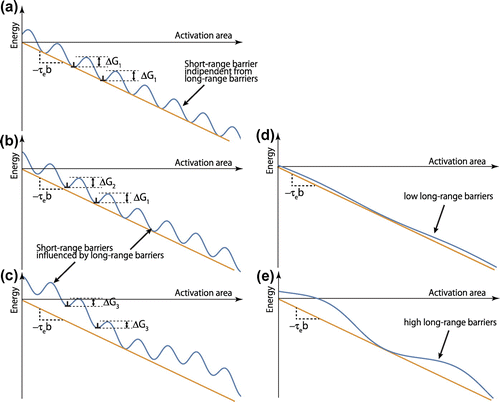
Figure (b) shows the case where the maximum height of the long-range barrier is 0.2 times that of the short-range barrier, while the period of fluctuation of the long-range barrier is five times than that of the short-range barrier. Figure (d) shows the long-range barrier. Figure (a) is obtained by summing the short-range and long-range barriers in Figure (a) and (d), respectively. In this case, the shape of the short-range barrier which the dislocations need to overcome is somewhat influenced by the long-range barrier. However, ΔG2 is nearly the same as ΔG1 for the same τe value. Thus, ΔG2 can be regarded as being constant. In this case, the activation energy for dislocation gliding as determined experimentally is nearly the same as ΔG1.
Figure (c) shows the case where the maximum height of the long-range barrier is the same as that of the short-range barrier and the period of the fluctuation for the long-range barrier is five times that of the fluctuation of the short-range barrier; the specimen is the as-ARB-processed one. Figure (e) shows the long-range barrier. Figure (c) is obtained by summing the short-range and long-range barriers in Figure (a) and (e), respectively. Figure (c) shows the fluctuations in ΔG3 owing to the fluctuation of the long-range barrier. In this case, ΔG3 becomes smaller than ΔG1 or ΔG2 at some places. The dislocations, which are accidentally formed at the bottoms of the potential wells and have small activation energies, move preferentially during thermal activation. This model explains why the activation energy of the as-ARB-processed specimen is smaller when the athermal stress is relatively larger than the double-kink nucleation stress. It is to be noted that the fluctuations in the athermal stress cannot be detected through an analysis using Equations (2)–(5). The fluctuations in the athermal stress appear only when the effective stress and athermal stress are comparable. The athermal stress measured at room temperature must be the maximum value of the athermal stress in the system from the analogy of creep deformation. The point is that when the value of the effective stress is negligibly small compared to that of the athermal stress, the fluctuations are not detectable. In case of low temperatures, where the value of the thermal stress is comparable to that of the athermal stress, the fluctuations in the athermal stress are detectable via the change in the activation energy for dislocation gliding. It appears that, in such materials, severe deformation results in a number of dislocations.
In order to explain another aspect of materials subjected to SPD, namely the decrease in the effective stress, the effect of fluctuations in the athermal stress on the thermal activation process was taken into account. We defined the net value of τe as τe,net and calculated it as follows:(11)
where τe,ext and τe,flu are the effective stress determined experimentally (see Figure ) and the effective stress originating from the fluctuation in the athermal stress, respectively. For dislocations to glide in materials subjected to SPD, the τe,net value must be the same as that before the SPD process. This results in a change in τe,ext of Δτe,ext; the magnitude of this change is the same as –Δτe,flu, as expected from Equation (11).
Thus, the model proposed in this study could explain the simultaneous decreases in the activation energy, activation volume and effective stress in the case of specimens subjected to SPD. Further, gliding dislocations, whose activation energy is ΔG3, terminate after overcoming the Peierls barrier; this happens when they come to the bottom of higher activation energy, whose increase is attributable to the fluctuation in the athermal stress. Although these dislocations do not contribute to the plastic deformation process anymore, other dislocations that are also at different bottoms of the potential wells and have an activation energy of ΔG3 glide, resulting in an increase in the plastic strain. As per this mechanism, the dislocations located near the lower barriers move preferentially and contribute to the plastic deformation process.
In pure fcc metals, the primary barrier for dislocation gliding is the athermal stress [Citation19], and the contribution of the Peierls potential in preventing dislocation gliding is nearly negligible. In these materials, the long-range barriers are the main obstacles to dislocation gliding. Thus, the yield stress does not show a strong dependence on temperature. During the deformation of well-annealed pure bcc metals, such as coarse-grained iron, the primary barrier against dislocation gliding is the Peierls potential at low temperatures. Thus, in these materials, the short-range barriers are the main obstacles. As a result, the yield stress is strongly dependent on temperature. When the height of the long-range barriers is comparable to that of the short-range barriers, as is the case in severely deformed materials, the athermal stress has an effect on the effective stress. Then, the activation energy for dislocation gliding becomes smaller than that for non-deformed specimens. The contribution of the fluctuation in the athermal stress to the net effective stress is manifested as the SPD process continues.
5. Conclusions
It was found that the temperature dependence of the yield stress is weak in severely plastically deformed specimens. The observed decreases in the activation volume, activation energy for dislocation gliding and effective stress in these materials can be explained by taking into account the ratio of the athermal stress, which is significantly high, to the effective stress, as well as the fluctuation in the athermal stress.
Disclosure statement
No potential conflict of interest was reported by the authors.
Funding
This work was partly supported by the Ministry of Education, Culture, Sports, Science and Technology (MEXT), Japan, under a Grant-in-Aid for Scientific Research on Innovative Area titled ‘Bulk Nanostructured Metals’ [contract number 22102006] and by the Japan Society for the Promotion of Science under a Grant-in-Aid for Scientific Research (KAKENHI) [contract number 15H04147].
Acknowledgements
The authors thank Prof. N. Tsuji, Mr. S. Takano and Mr. K. Hata for their help with the experiments.
References
- N. Tsuji, S. Okuno, Y. Koizumi, and Y. Minamino, Toughness of ultrafine grained ferritic steels fabricated by ARB and annealing process, Mater. Trans. 45 (2004), pp. 2272–2281.10.2320/matertrans.45.2272
- M. Tanaka, K. Higashida, T. Shimokawa, and T. Morikawa, Brittle-ductile transition in low carbon steel deformed by the accumulative roll bonding process, Mater. Trans. 50 (2009), pp. 56–63.10.2320/matertrans.MD200817
- M. Tanaka, S. Takano, and K. Higashida, Enhancement of low temperature toughness in bulk nanostructured metals, Mater. Trans. 54 (2013), pp. 1624–1628.10.2320/matertrans.MH201319
- X. Huang, N. Hansen, and N. Tsuji, Hardening by annealing and softening by deformation in nanostructured metals, Science 312 (2006), pp. 249–251.10.1126/science.1124268
- S. Berbenni, V. Favier, and M. Berveiller, Impact of the grain size distribution on the yield stress of heterogeneous materials, Int. J. Plast. 23 (2007), pp. 114–142.10.1016/j.ijplas.2006.03.004
- T. Shimokawa, T. Hiramoto, T. Kinari, and S. Shintaku, Effect of extrinsic grain boundary dislocations on mechanical properties of ultrafine-grained metals by molecular dynamics simulations, Mater. Trans. 50 (2009), pp. 2–10.10.2320/matertrans.MD200810
- R. Song, D. Ponge, D. Raabe, J.G. Speer, and D.K. Matlock, Overview of processing, microstructure and mechanical properties of ultrafine grained bcc steels, Mater. Sci. Eng. A 441 (2006), pp. 1–17.10.1016/j.msea.2006.08.095
- T. Kunimine, N. Takata, N. Tsuji, T. Fujii, M. Kato, and S. Onaka, Temperature and strain rate dependence of flow stress in severely deformed copper by accumulative roll bonding, Mater. Trans. 50 (2009), pp. 64–69.10.2320/matertrans.MD200809
- Y. Saito, N. Tsuji, H. Utsunomiya, T. Sakai, and R.G. Hong, Ultra-fine grained bulk aluminum produced by accumulative roll-bonding (ARB) process, Scr. Mater. 39 (1998), pp. 1221–1227.10.1016/S1359-6462(98)00302-9
- E.O. Hall, The deformation and ageing of mild steel: III discussion of results, Proc. Phys. Soc. B64 (1951), pp. 747–753.10.1088/0370-1301/64/9/303
- N.J. Petch, The cleavage strength of polycrystals, J. Iron Steel Inst. 174 (1953), pp. 25–28.
- A. Seeger, The temperature dependence of the critical shear stress and of work-hardening of metal crystals, London, Edinburgh, Dublin Philos. Mag. J. Sci. 45 (1954), pp. 771–773.10.1080/14786440708520489
- S.K. Mitra and J.E. Dorn, On nature of strain hardening in face-centered cubic metals, Trans. Metall. Soc. AIME 224 (1962), pp. 1062–1071.
- J.F.W. Bishop and R. Hill, A theory of the plastic distortion of a polycrystalline aggregate under combined stresses, London, Edinburgh, Dublin Philos. Mag. J. Sci. 42 (1951), pp. 414–427.10.1080/14786445108561065
- M.J. Marcinkowski and H.A. Lipsitt, The plastic deformation of chromium at low temperatures, Acta Metall. 10 (1962), pp. 95–111.10.1016/0001-6160(62)90055-X
- J.M. Rosenberg and H.R. Piehler, Calculation of the Taylor factor and lattice rotations for bcc metals deforming by pencil glide, Metall. Trans. 2 (1971), pp. 257–259.10.1007/BF02662666
- U.F. Kocks, Relation between polycrystal deformation and single-crystal deformation, Meta. Trans. 1 (1970), p. 1121.
- Y. Aono and E. Kuramoto, Plastic deformation of high-purity iron single crystals, Rep. Res. Inst. Appl. Mech. Kyushu Univ. XXIX (1981), pp. 127–193.
- A.H. Cottrell and R.J. Stokes, Effects of temperature on the plastic properties of aluminium crystals, Proc. Royal Soc. A: Math. Phys. Eng. Sci. 233 (1955), pp. 17–34.10.1098/rspa.1955.0243

